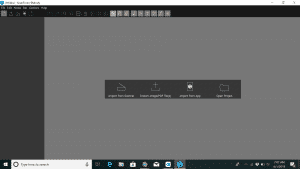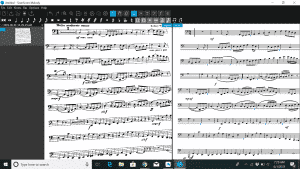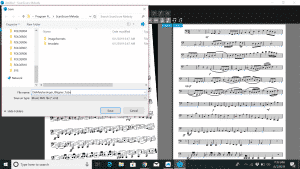In this short guide, we’ll walk you through exactly how to scan sheet music into MuseScore using our software, ScanScore.
In 2002, Werner Schweer started a new hobby – developing a completely free music editing software that could be used by educators and musicians everywhere. The problem, as he saw it, was the firm grip larger companies had on the music editing industry and the high prices they charged for their products.
Schweer and his partners went on to develop and present MuseScore to the world.
Branded as the “World’s Most Popular Notation Software,” MuseScore is unique in its balance of quality and free access. But what it does lack is a simple and accurate way to scan sheet music into an editable, digital form.
By providing this key service, ScanScore has become the perfect companion to MuseScore.
This post lays out easy instructions for you to follow so you can scan your physical sheet music into MuseScore with ScanScore quickly.
Step By Step Instructions
Read through the directions carefully so you get a good grasp of what you need to do.
1) Check your programs for updates
The first thing to do is to download the programs. If you’ve done this previously, it’s a good idea to check both the programs for any updates.
MuseScore is completely free and available on Windows, Mac, iPhone/iPad, Android and Kindle Fire. For scanning sheet music with ScanScore, the Windows and Mac options are the most relevant.
ScanScore is compatible with Windows and Mac. There are also app versions available on the Google Play Store and at the App Store for Apple devices.
Note: To use our app, please scan the QR code you will find on the desktop program to pair your devices. We introduced the code to prevent people from stealing the program. But don’t worry, as a paying subscriber you are able to use ScanScore on up to three devices.

2) Scan the notation
With both programs up and running, you’re ready to scan your sheet music. Fire up the ScanScore program and on the opening screen you’ll be asked how you want to scan in the music:
- Scanner – This option accesses your actual scanner. A direct scan from a purposeful device usually provides the best results.
- Import from file – You can import a PDF or image type file. If the quality of the image is good, this can be very effective.
- Scan with the app – You can also take a picture using the app. Be careful to get the best image you can, a poor picture will result in a poor digital copy.
Pro-tip: To get as clear an image as possible, ensure the sheet music has good lighting and the image is taken at a parallel angle to the score.

3) Proof for mistakes
It’s here that ScanScore really starts to shine.
After your image is scanned, you’ll get a side-by-side view of the original and digital versions for quick and easy comparison. You can now proof your digital version for any scanning errors.
ScanScore helps with this by catching some of the mistakes and highlighting them in blue and purple for you to see. When you find a mistake, simply drag a rectangle over the notes and change them with the easy-to-use toolbar.
The zoom function is another useful feature ScanScore offers. You’ll see that when you zoom in on the digital version of the piece, the original zooms in at the exact same spot giving you a detailed look at each part.
We suggest, for final proofing, you use the MIDI playback option.
Pro-tip: To protect your work as you go, remember to save your file regularly. To do this, simply click the “Save as” option under the “File” menu.

4) Export to MusicXML file
Once you’re sure everything is correct it’s time to export the file into a MusicXML file. This file type is the standard used in most notation programs for editing sheet music, including MuseScore.
To export, click on the “export to MusicXML” button on the left of the ScanScore screen. And then select where you would like to save it. (We recommend saving all your MusicXML files in one place so you can find them easily.)
Pro-tip: Save your file under a name that describes the work so it is easy to remember. I suggest the following format ” piece_composer_part.” Example: “FugueGminor_JSBach_organ.”
5) Import into MuseScore
It’s now time to import the file into MuseScore. This step is simple to do if your program is up-to-date.
Open up your MuseScore program. Go to the “File” menu and select “Open in MuseScore.” Then, find your labeled MusicXML file and select it to open.
After a brief moment, the file should appear in MuseScore’s program. Congrats! You have now successfully scanned music into MuseScore using ScanScore.
Note: With other notation programs, you can select the file itself and choose “Open with …” when you right-click. However, MuseScore users have told us this does not work as well as opening from the MuseScore program itself.
For more information about using ScanScore, please check out our introductory video.
Commonly Asked Questions
Is ScanScore able to read all sheet music? – A resounding yes! If you’re using Western notation (excluding things like Gregorian chant), then ScanScore should read the notation without any problem. ScanScore has three options for different kinds of scores.
ScanScore Melody is the most affordable and can be used to read one stave scores.
With ScanScore Ensemble, you can scan up to four staves per system – great for small groups and ensembles.
ScanScore Professional is the more expensive option but can handle almost any full score (and a maximum of 32 staves).
Can I just use ScanScore to edit my sheet music? – Yes. ScanScore is designed to easily scan and correct sheet music. You can edit it there or in another notation software that you are already used to like MuseScore.
Here are some things ScanScore is able to do:
- Layout
- Transposition
- Parts
- Specific instrument playback
ScanScore’s place in your music editing setup is supposed as a highly effective scanner. From there, your results can be used with specialized editing software or you are good with ScanScore alone!
Conclusion
These simple steps will help you scan music into MuseScore using ScanScore. If you need any help, please go to ScanScore Support.
Here’s a quick review of the steps we’ve covered in this post:
- Check your programs for updates
- Scan the notation
- Proof for mistakes
- Export to MusicXML file
- Import into MuseScore
Have fun writing music!


I had a little trouble the first time I used it, and so I contacted ScanScore Support. They walked me through all the steps and were so helpful. Now, I know how to import PDFs from IMSLP. Thank you!
I tried the procedure stated in this article as I am using the trial version on the second day. When I imported the generated Music XML file to Musescore, system displays “not a valid MusicXML file, do you want to load it anyway”? Same error message is displayed for Sibelius First and the system does not allow to import the file at all. Seems some issue in the generated Music XML file. Hope to hear the resolution so that I shall get ScanScore to work with Musescore.
Would be good to set an instrument for the XML export. Then the correct transposition will be configured.
Currently I have to manually add the transpose settings before importing into MuseScore.
Dear Craig,
we are working on that kind of features. Thanks for your feedback.
Matt
ScanScore Support
Pingback: 5 Steps for Importing a PDF into MuseScore Using ScanScore | SCANSCORE